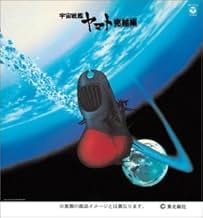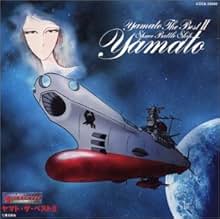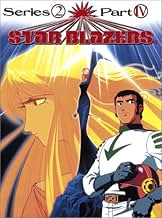Space Battleship Yamato
- Série télévisée
- 1979–1984
- 22min
Ajouter une intrigue dans votre langueIn the year 2199, a starship must make a dangerous voyage to the distant planet Iscandar and back to save Earth from an alien invasion.In the year 2199, a starship must make a dangerous voyage to the distant planet Iscandar and back to save Earth from an alien invasion.In the year 2199, a starship must make a dangerous voyage to the distant planet Iscandar and back to save Earth from an alien invasion.
Avis à la une
The references to World War II are obvious: fighting an almost hopeless war against an evil, corrupt empire. The enemy leader, Desslok, even looks like a Nazi with the uniform he wears. The story is emotionally driven: fraught with patriotism, sacrifice, and the desperation to save Earth. The writers employ healthy doses of characterization and detail, something sadly lacking in most other series. Lots of morality and spiritualism are brandished effectively such as (paraphrased) "don't destroy other worlds in desperation, even though Earth will die in less than a year", "with great power comes great responsibility", "take pains not to harm indigenous life on other worlds", "take the blame for your actions and move on", "in spite of all the Capt has lost, he goes on, indomitable", and "your brother survives in you."
Part of the series' attraction is the epic space battles. The see the animators craft the ships and their weaponry, and put them into action, is a sight to behold. "Space planes" soar in formation around the enemy and bristle with missiles and torpedoes. Weapons of mass destruction are brought into play to save the day. And the battleship Argo itself is such a work of art. Its splendor is shown off in a vast array of combat attitudes. They couldn't resist having the ship land in on an ocean, so that its seagoing superstructure and profile could be admired (powerfully reminiscent of the sea battles in our history). Overall, the heroic spirit personified by ship and her crew is exploited to the hilt, and it's hard to resist cheering for them in spite of the melodrama.
In case you missed the plot summary: hostile Aliens (the Gammalons) attack Earth and defeat all of her military might. The Gammalons then proceed to launch a years-long nuclear attack against Earth which renders the entire surface unfit for life. Cowering in caves, humanity awaits its final extinction...
Until a message is received from the Planet Iscandar, offering aid. Iscander can provide "Cosmo DNA," which can resuscitate the Earth's entire ecosphere. Iscander also provides the blueprints for a powerful interstellar propulsion system: the wave motion drive. Desperate beyond measure, Earth refits one single starship, the Argo, with the wave motion drive, and sends her and her brave crew to cross 100,000 light years of Gammalon territory to reach Iscandar.
Right away, one can see that this cartoon has a much more intelligent plot than any shows intended for kids and adolescents. It is also notable that this series is a serial: each episode is part of a larger, evolving story. It would be decades before any American shows that are not "soap operas" would develop this format (like Buffy the Vampire Slayer). The plot is also dead serious: the world is ending, and ending in a way that was plausibly frightening to Japanese kids in the wake of Hiroshima and American kids in the wake of Three Mile Island. This didn't so much scare me as a kid, but it made the show totally riveting.
On top of the smart and emotional plot, the series had some other virtues. The "cinematography" was great, with good drawing and well-composed scenes. The lessons of the episodes were more serious and adult than typical kids shows, focusing on duty, loyalty, teamwork, and honor. The episodes themselves got a bit formulaic in the middle of the first season, usually ending in a desperate battle with Gammalon ships which can be won only be use of the wave-motion gun.
Sorry to be so long winded. If you like anime and you like sci-fi, you should watch at least the first season. Its better than a lot of anime than came after, and much more original than most anime. The second season was very good, too, although it was even more serious.
Being young and impressionable, I suppose I was sucked in by the glamour of being in outer space, fighting aliens and saving the day. But, as I look back, the drama was good enough that I would want to see it all again, nearly 20 years later. And, in the spirit of that, I've found that you can currently watch the 2nd season of Star Blazers on Cartoon Network under the Toonami/Reactor section.
It's just as good as I remembered...
Le saviez-vous
- AnecdotesInitially canceled in Japan due to low ratings, the series gained a new lease of life there after Star Wars: Épisode IV - Un nouvel espoir (1977) was released.
- Citations
[First season opening theme]
Chorus: We're off to outer space / We're leaving Mother Earth / To save the human race / Our Star Blazers / Searching for a distant star / Heading off to Iscandar / Leaving all we love behind / Who knows what dangers we'll find? / We must be strong and brave / Our home we've got to save / If we don't in just one year / Mother Earth will disappear / Fighting with the Gamilons / We won't stop until we've won / Then we return and when we arrive / The Earth will survive with our Star Blazers!
- ConnexionsAlternate-language version of Uchû senkan Yamato (1974)
- Bandes originalesUchuu Senkan Yamato
by Isao Sasaki & the Royal Knights
Opening Theme
Meilleurs choix
- How many seasons does Star Blazers have?Alimenté par Alexa
- How many episodes did this series have?
- What additional Yamato properties exist beyond those that were dubbed as Star Blazers?
- How does Star Blazers differ from Yamato?
Détails
Contribuer à cette page

























